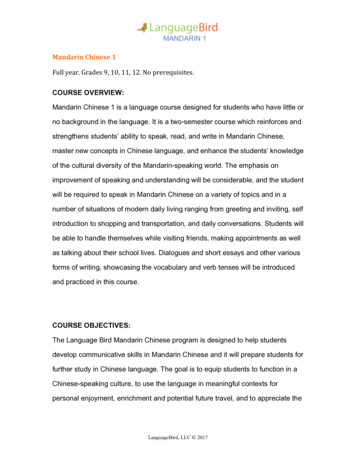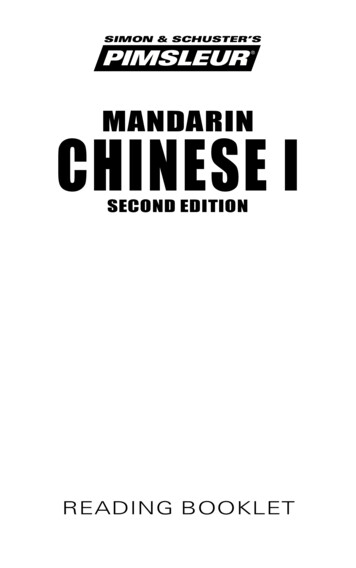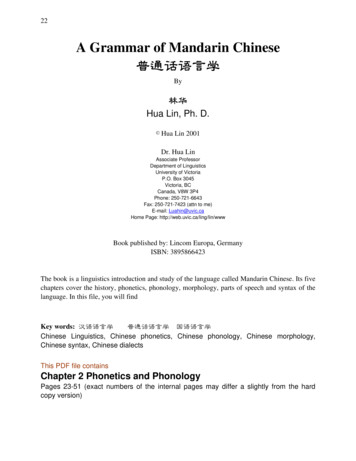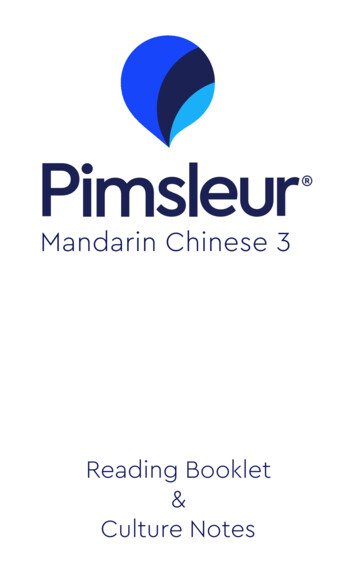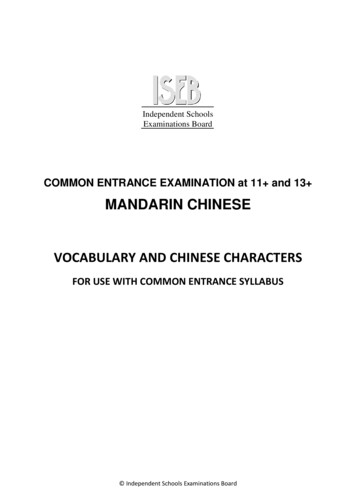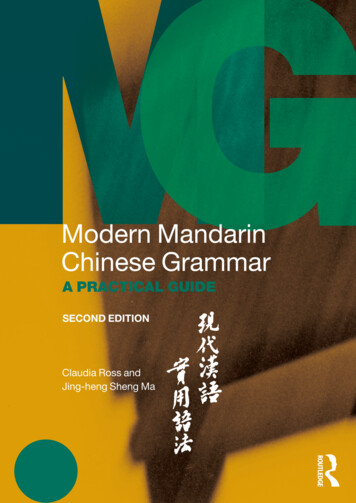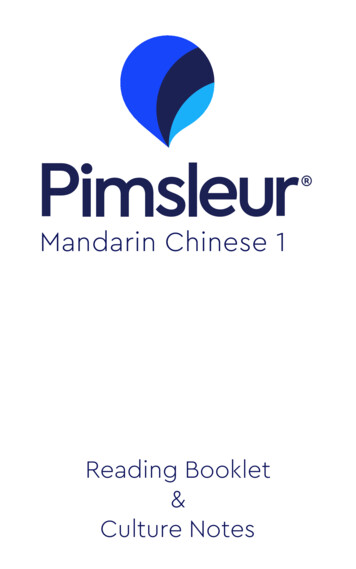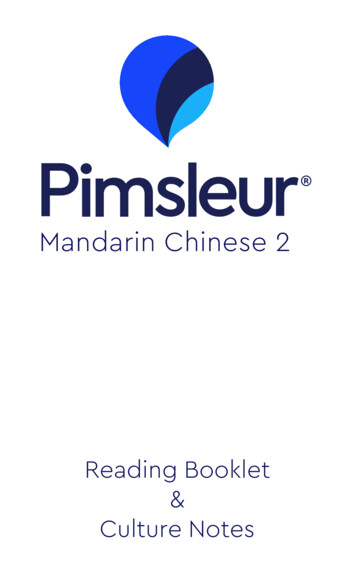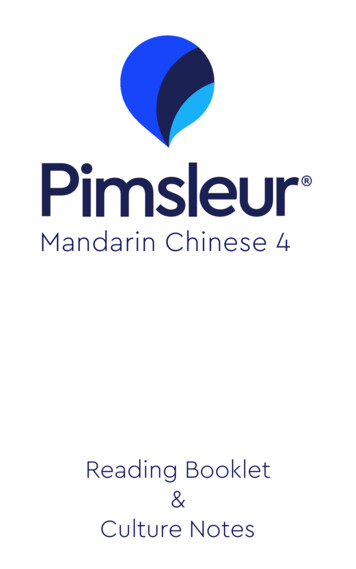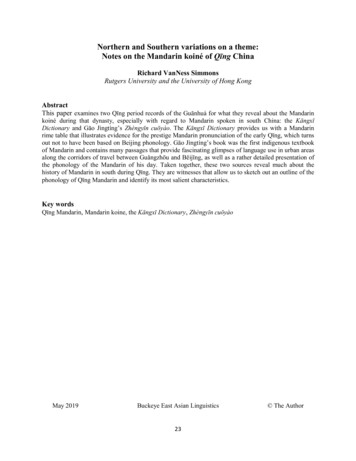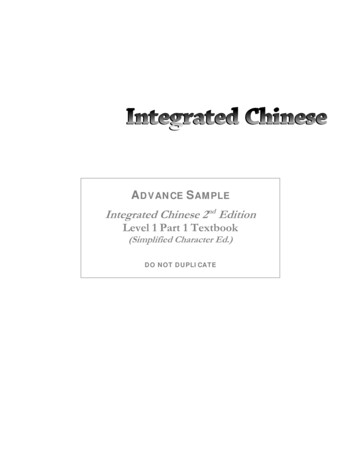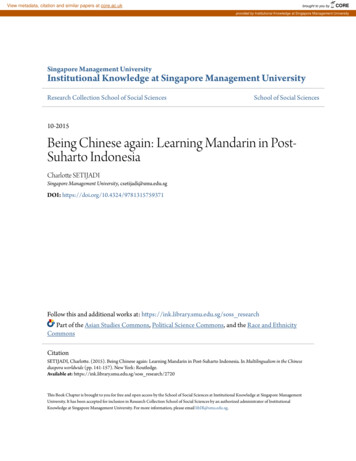
Transcription
View metadata, citation and similar papers at core.ac.ukbrought to you byCOREprovided by Institutional Knowledge at Singapore Management UniversitySingapore Management UniversityInstitutional Knowledge at Singapore Management UniversityResearch Collection School of Social SciencesSchool of Social Sciences10-2015Being Chinese again: Learning Mandarin in PostSuharto IndonesiaCharlotte SETIJADISingapore Management University, csetijadi@smu.edu.sgDOI: https://doi.org/10.4324/9781315759371Follow this and additional works at: https://ink.library.smu.edu.sg/soss researchPart of the Asian Studies Commons, Political Science Commons, and the Race and EthnicityCommonsCitationSETIJADI, Charlotte. (2015). Being Chinese again: Learning Mandarin in Post-Suharto Indonesia. In Multilingualism in the Chinesediaspora worldwide (pp. 141-157). New York: Routledge.Available at: https://ink.library.smu.edu.sg/soss research/2720This Book Chapter is brought to you for free and open access by the School of Social Sciences at Institutional Knowledge at Singapore ManagementUniversity. It has been accepted for inclusion in Research Collection School of Social Sciences by an authorized administrator of InstitutionalKnowledge at Singapore Management University. For more information, please email libIR@smu.edu.sg.
Published in Multilingualism in the Chinese diaspora worldwide. 2016. Routledge. pp. 141-157.9Being Chinese AgainLearning Mandarin in Post-SuhartoIndonesiaCharlotte SetijadiINTRODUCTIONFor thirty-two years under former President Suharto’s New Order regime(from 1966–1998), the teaching of Chinese languages in schools was bannedin Indonesia. During this period of total assimilation, public displays ofChinese characters, along with other forms of Chinese cultural expressions,were prohibited, allegedly for the sake of national unity. From 1966–69,hundreds of Chinese medium schools and Chinese language press wereclosed in Chinese settlements throughout the archipelago, and the formalteaching of Chinese languages in Indonesia effectively ceased. As a result,the majority of contemporary Chinese Indonesians no longer have the ability to speak, let alone write in, Chinese.As has been extensively documented, the situation only changed when,after months of economic crisis, political instability and student protestsdemanding the resignation of President Suharto, the chaos culminated inlarge-scale lootings, destruction of properties and rape of ethnic Chinesewomen between 12 and 14 May 1998 in Jakarta, Solo and other majorcities (see Hoon, 2007; Purdey, 2006). Soon after, the New Order regimecollapsed and a new era of reform (reformasi) began, with promises of civilsociety, democracy, civil liberties and justice. The post-Suharto sociopolitical atmosphere could not be more different for the ethnic Chinese, wherebyalmost immediately, subsequent reformasi governments abolished almost allassimilationist policies, ushering in a ‘revival’ of Chinese identity (see Hoon,2007; Setijadi, 2010). Since 1998, there has been a steady increase in thenumber of Chinese language courses and programs at Indonesian schoolsand universities, particularly in areas with large ethnic Chinese populations.Indeed, after three decades of assimilation, many Chinese parents—themajority of whom do not speak Chinese themselves—want their children tolearn Chinese in order to ‘reconnect’ to a ‘lost’ Chinese identity. At a morepragmatic level, they are also deeply aware of the potential economic advantages of knowing Mandarin for the purposes of their children’s future careeradvancement, trade and guanxi with rapidly rising China. This pragmatismis reflected in the overwhelming popularity of Mandarin (particularly the
142 Charlotte Setijadistandardised Putonghua variety used as the national language in China) asthe language to learn, and not regional dialects such as Teochew, Hakka orHokkien, originally spoken by the majority of Chinese migrants in the Indonesian archipelago. The youth themselves seem to embrace learning Mandarin with many increasingly engaging in code switching between English,Mandarin and Indonesian in social interactions. In addition, the ability tospeak or at least understand Mandarin also enables young Chinese Indonesians to further imagine themselves as part of a modern pan-Chinese youthidentity they see in transnational Mandarin and Cantonese films, TV seriesand pop culture.Looking at all these trends, the ability to speak Chinese (particularlyMandarin) appears to play an important part in the construction of Chineseidentities in the post-Suharto era. Thus far, however, little is known aboutthe linguistic practices and beliefs of contemporary Chinese Indonesians.Furthermore, considering that only fifteen years ago, Chinese languagesand culture were banned, questions also need to be asked regarding howthe ‘return’ of Chinese languages in public are perceived by Chinese andnon-Chinese Indonesians. Using ethnographic interviews with twenty-fiveyoung Chinese Indonesians1 ages 18 to 35 from both genders conducted inJakarta from 2008–2012, this chapter examines how young post-SuhartoChinese view their ethnic identity and belonging in relation to their ability (or inability) to speak Chinese. This chapter also discusses the tensionsbetween competing ideologies on ethnicity, nationalism and culture asembodied in the daily negotiations of which language(s) to speak and when.CHINESE INDONESIANS, CHINESENESS AND CHINESELANGUAGES IN INDONESIAThe prohibition of Chinese languages during the New Order period wasonly one example of the many instances of anti-Chinese discriminationthat had occurred almost consistently throughout the history of Chinesesettlement in the Indonesian archipelago. Whereas the Chinese had had along history of migration to Indonesia that began in pre-colonial times, theDutch colonial policy of racial segregation successfully perpetuated a negative image of the Chinese as economically dominant ‘essential outsiders’who did not sympathise with the plight of the native (‘pribumi’ in Indonesian) population (Chirot and Reid, 1997). Throughout the periods ofDutch colonialism, independence struggle and the early days of the Indonesian Republic, the Chinese’s belonging and national identity in Indonesiaremained ambiguous at best, regardless of the fact that many ethnic Chinese were nationalists who supported the independence cause. As FilomenoAguilar, Jr. suggests, in the course of Indonesian nationalist awakening,the Chinese were attributed a definite, distant place of origin—China—andthus the descendants of Chinese migrants became ‘indelibly linked to the
Being Chinese Again143first-generation immigrants and, in an unbroken chain, remained foreveraliens’ (2001: 517).Chinese Indonesians themselves were, and always had been, a heterogeneous group consisting of people that came from various regions in China,spoke different languages (Hakka, Hokkien, Cantonese and Teochew beingthe four major spoken languages), held different political views and feltvarying degrees of belonging towards the Indonesian nation. The traditionalgroupings of Chinese Indonesians as either ‘totok’ (‘pure’ Chinese with nomixed ancestry) or ‘peranakan’ (acculturated Chinese, usually with mixedChinese-native Indonesian ancestry) illustrate the different ‘types’ of Chinesein Indonesia with different connections to the Chinese homeland, languageand culture2 (see Coppel, 1983). Unlike the totok Chinese who maintainedChinese traditions, culture and language in Indonesia, the peranakan Chinese mostly identified with the cultures of their local regions, spoke locallanguages instead of Chinese and developed their own unique hybrid culturefrom a mixture of Chinese and local cultural influences. Nevertheless, thediscourse of ‘Masalah Cina’ (the ‘Chinese Problem’) in Indonesia collapsedthe diversity of ethnic Chinese lives into one alleged problem that needed tobe ‘fixed’ with a convenient phraseology.Following the alleged failed communist coup of 30 September 1965(G-30S/PKI in the national terminology), in which many ethnic Chineseindividuals and organisations were implicated, President Suharto’s NewOrder regime ‘took control’ of rising anti-Chinese sentiment with a seriesof assimilationist legislations (see Cribb & Coppel, 2009). In 1966, CabinetPresidium Decision 127 required all ethnic Chinese to discard their Chinesenames and adopt ‘Indonesian-sounding’ ones. In 1967, Presidential Instruction Number 14 on Chinese Religion, Beliefs, and Traditions effectivelybanned any Chinese literature and public displays of cultural expression inIndonesia, including the prohibition of Chinese characters. Furthermore,as part of the ‘Basic Policy for the Solution of the Chinese Problem’ (Presidential Decision No. 240 of 1967) and other measures, only one heavilymonitored Chinese-language newspaper was allowed to continue and allChinese language schools were eventually phased out. Buildings and properties owned by Chinese educational organisations were seized and ‘nationalised’ for use by state-run schools. Sai Siew-Min (2010) estimates that, inthe late 1960s, the ban on Chinese language education affected 629 schools,6,478 teachers and 272,782 students in eleven cities across Indonesia.3The prohibition of Chinese languages throughout the New Order wasconsistent with the prevalent national language ideology at the time thatviewed the elimination of ‘non-native’ languages such as Chinese as necessary for national unity. Since the beginning of the Indonesian nationalistmovement in the early twentieth century, the Malay language came to beseen as a strong contender as the emerging nation’s lingua franca becauseit was perceived as a common language of the natives (Kahin, 1963). Atthe historic Second Youth Congress on 28 October 1928 when youth
144 Charlotte Setijadidelegations from native ethnic groups across the archipelago pledged theiroath (known from then on as the ‘Youth Oath’) towards a unified Indone sian nation, modernised Malay (renamed ‘Indonesian’) was adopted as thelanguage of the new nation, privileged above all other native and non-nativelanguages. The centrality of Indonesian as the language of national unitywas evident in its teaching as a compulsory language in schools and asthe only language of politics, trade and national culture, although thegovernment was committed in principle to protecting local languages.As non-native languages spoken by a sociopolitically ‘problematic’ ethnic minority, the prohibition of Chinese languages was easily justified. Inthis regard, the banning of Chinese reflected the popular view of ChineseIndonesians as essentially foreigners within the framework of Indonesia’sethno-nationalist ideology.Ariel Heryanto (2006) argues that the effect of the assimilation policieswas the lasting image of Chineseness as ideologically unclean, dangerous,shameful and therefore in need of erasure. Connections with China in thelate 1960s had strong communist connotations, and anyone caught speakingin Chinese was viewed with strong suspicion and anger. Chinese languagesbecame confined to the private domains, and many parents stopped teaching their children Chinese altogether. Over the three decades of assimilation from 1966 to 1998, Chinese Indonesian language, culture and identitywere in many ways ‘erased’ or at least hidden from public view, althoughtheir forced assimilation also had the paradoxical effect of accentuating thegroup’s essential foreignness in the national imagination.As mentioned before, the end of the New Order marked the beginningof a new Chinese identity politics that started with demands for the abolition of assimilationist laws and justice for the victims of the May ’98rapes and riots (see Budiman, 2005; Purdey, 2006; Turner, 2003). Indeed,post-Suharto governments were only too eager to prove their commitmentto human rights issues and move away from the harmful legacies of the NewOrder and May 1998 by implementing new laws that recognised the rightsof Chinese Indonesians. The Habibie government (1998–1999) started offthese reforms through a Presidential Instruction that abolished the use of theterms ‘pribumi’ and ‘non-pribumi’ in official government documents. In theyear 2000, the newly elected President Abdurrahman Wahid (1999–2001)revoked bans against Chinese languages, religion and cultural expressions,allowing Chinese culture to be practiced in public once more. PresidentMegawati Sukarnoputri (2001–2004) made Imlek (Chinese New Year) anational holiday in 2002 as an official gesture of recognition for both Chinese Indonesians and the Confucian (Konghucu) religion that was added asone of the state’s six official religions. The stark contrast between the NewOrder and the post-Suharto era led many ethnic Chinese to view the reformasi era as a time for the revival of Chinese culture in Indonesia.One of the most noticeable changes that occurred in the post-Suhartoera is the return of Chinese languages and script in the public domain.
Being Chinese Again145Previously banned, Chinese characters could be seen on posters, bannersand store decorations, particularly during annual Imlek celebrations. Moreand more, Mandarin and other Chinese languages are being spoken in public by Chinese Indonesians who feel that it is now ‘safe’ to speak Chinese infront of pribumi Indonesians. Perhaps more significantly, the fall of the NewOrder has seen what Leo Suryadinata calls ‘a watershed for Chinese education’ (2008: 4). In the last fifteen years, the demand for Mandarin, particularly among Chinese Indonesian students, has led to language courses beingoffered in many private and public schools, often as part of the NationalPlus curriculum, according to which classes are delivered in a combinationof Indonesian, English and Mandarin. The number of private Mandarin language course providers has also mushroomed in the last decade, especiallyin urban residential areas with large concentrations of middle to upper classChinese Indonesian families (see Kaboel & Sulanti, 2010). On their part,the PRC government is clearly encouraging the demand for Mandarin language in Indonesia with the opening of seven Confucius Institutes attachedto universities in major Indonesian cities. Additionally, in the past five years,a number of alumni organisations made up of older generation ChineseIndonesians who were ex-graduates of Chinese-medium schools, such asthe disbanded Tiong Hoa Hwee Koan (Chinese Association) schools, hadre-established their pre-Suharto schools with the mission to revive Chineseeducation for post-Suharto youth. Such organisations include the PaHoaalumni group that established the PaHoa National Plus School in the outersuburbs of Jakarta, the PaChung group that established two schools inJakarta and the MaChung group that established MaChung University inMalang, East Java (see Setijadi, 2010).For many middle- and upper-class Chinese Indonesian families, it makessense to send their children for Mandarin extracurricular lessons or toNational Plus schools, especially if they plan on sending their children toChina or Taiwan for language or tertiary education. Indeed, in recent years,more and more Chinese Indonesian youth from affluent families go to Chinanot only for language study but also for tertiary education degrees. Forinstance, data from the Indonesian embassy in Beijing suggest that whereasin 1998, only around 1,000 Indonesian students studied at Chinese universities, in 2012 the number had risen to over 9,000 (Priyambodo, 2012).This is a growing trend away from the dominance of Western countriessuch as Australia, the US and the UK as the common destinations for Indonesian students pursuing overseas education. Whereas non-Chinese Indonesian students are included in this figure, a large majority are ethnic Chineseyouths with hopes of creating a future employment niche for themselves notonly with an overseas university degree but also knowledge of modern Chinese language and society. Many among them also hope that their Chineseethnicity will increase the possibility of future advantageous guanxi4 connections for career advancement and trade opportunities with China andother Chinese-speaking countries.
146 Charlotte Setijadi‘YOU’RE NOT A REAL CHINESE IF YOU CAN’T SPEAK CHINESE’:LANGUAGE IDEOLOGY AND CHINESE INDONESIAN IDENTITYAt the core of this post-Suharto ‘revival’ of Chinese language use and education is a belief that Chinese Indonesians must now seize the opportunityto re-learn Chinese languages and reclaim a Chinese identity that was lostto the generations that grew up under the New Order. The term ‘lost generation’ has been frequently used by scholars, observers and the ChineseIndonesian public more generally to refer to the post-1965 generation whonever learned Chinese, possess little or no knowledge of Chinese cultureand had been made to feel ashamed about being Chinese (see Hoon, 2007;Suryadinata, 2008). Many of the older, Chinese-educated totok Chinese inparticular expressed concerns that contemporary young Chinese Indonesians do not know their identity and the long, proud history of the Chinesepeople. In an interview, Teddy Jusuf, a former Indonesian Army Generaland prominent Chinese Indonesian elder who himself was Chinese-educatedin the 1940s, complained that:The [Chinese] youth today cannot speak Mandarin, do not know Chinese culture, and had become completely dissociated from their family’sname and heritage. . . . They do not know who they are. . . . It is thejob of the older generation to encourage the youth to learn about theirChinese identity again. . . . In particular they need to learn Mandarin sothey can understand the culture. (author’s translation from Indonesian)In a similar vein, Koko Tanumihardja, a PaHoa alumni and founder of thenew PaHoa School remarked:I remember going to school at the old PaHoa school in Patekoan, andI also remember the sadness I felt when the government forcibly closedthe school. . . . Not just our school but also all Chinese schools in Indonesia. It was a tragedy for the Chinese, because without the schools, welost all sense of who we are and the values that set us apart as a people.My children for example, can’t speak Mandarin, although I did try toinstil Chinese moral values as much as I could while they were growingup. . . . The younger generation now, they are lucky that they could haveChinese education again. . . . Chinese schools like PaHoa need to beresurrected so that the younger generation can re-learn what was lost.(author’s translation from Indonesian)Evident in what Pak (Mister) Teddy and Pak Koko said is a common ideaamong Chinese Indonesians that the ability to speak Chinese is intrinsicallylinked to Chinese culture and identity.The belief in the cultural significance of Chinese language is prevalentamong Chinese people both in China and in overseas Chinese diaspora
Being Chinese Again147around the world. As scholars note time and time again, most Chinese—eventhose who do not speak Chinese themselves—hold the position that withoutthe ability to speak Chinese, a Chinese person could never be a ‘complete’Chinese (see Li & Zhu, 2010; Tu, 1991; Wang, 1991). Here, the abilityto read and write in Chinese is desirable, but a Chinese person should atleast be able to speak Chinese. For ethnic Chinese living in overseas Chinese diaspora, the issue is arguably even more complicated considering that,as Chinese who live in the ‘periphery,’ Chinese languages and culture areoften preserved with particular zeal as the means by which overseas Chinese (huaqiao) could maintain their connection with China as the mythicalhomeland. In her book On Not Speaking Chinese: Living Between Asia andthe West, Ien Ang argues that for ethnic Chinese in diaspora, the inabilityto speak Chinese is ‘a condition that has been hegemonically constructedas a lack, a sign of loss of authenticity’ (2001: 30). According to this logic,Chinese persons who somehow ‘lost’ the ability to speak Chinese are constructed as inauthentic or ‘fake’ Chinese, both by others and by themselves.Indeed, during interviews with young Chinese Indonesians, this ideology about the importance of Chinese language to identity is prevalent andwould often come up during conversations about how the youth view theirChineseness in relation to their ability (or inability) to speak Chinese. Forexample, in an interview with Ben and Fenny, two 30-year-old peranakanChinese, they joked about how they were ‘fake’ Chinese (cina palsu) becausethey did not know how to speak Chinese:Ben: It is actually quite funny that the pribumi call me Chinese because actually, a real Chinese person would neverpass me as a Chinese [laughs].Interviewer: What do you think makes a real Chinese person?Ben: Well, for one, you’d have to be able to speak Chinese,which I can’t.Fenny: That’s right, I’m a fake Chinese too like Ben [laughs].My grandparents could still speak Chinese [Hakka], butmy parents were never taught properly and could onlyspeak a little bit of Chinese. But my siblings and I, wecan’t speak any Chinese at all.Ben: So your family gets faker and faker [as Chinese] witheach generation [laughs].Fenny: Yeah, you can say that, we got diluted over time! [laughs]Ben: Everyone knows that you’re not a real Chinese if youcan’t speak Chinese.(author’s translation from Indonesian)For young people like Ben and Fenny, the experience of realising their statusas a so-called ‘fake’ Chinese could sometimes be a harsh one, as discoveredby Alex, a 32-year-old male from a totok Chinese background who felt hurt
148 Charlotte Setijadiwhen he thought that people in mainland China did not regard him as a‘real’ Chinese while on a family trip to China:Growing up, I was always told that I should be proud of being a Chinese, and our family spoke Hokkien at home. I only knew very little Mandarin, but when our family went to China for holiday, I triedspeaking in Mandarin to shopkeepers and when ordering food. . . . Butthe shopkeepers would talk back to me really fast, and I couldn’t understand what they were saying! They just looked at me like they wereangry at me for not being able to speak proper Chinese. . . . I felt so sadbecause I felt like I didn’t belong there [in China] and that I was nota real Chinese. . . . Now I know that other Chinese people, especiallythose in the mainland, don’t regard us Chinese Indonesians as Chineseanyway. (author’s translation from Indonesian)Although Alex’s experience of being regarded as inauthentic is quite common among overseas Chinese and members of other diaspora, the Chinese Indonesian experience is unique because, feeling like they are neitheraccepted as Indonesian nor Chinese, many Chinese Indonesians are unsureabout where they belong.In many ways, being able to speak Chinese carries a particular symbolicsignificance for Chinese Indonesians in the post-Suharto era as they nowstruggle to reclaim what is perceived as a lost Chinese identity. If in the past,speaking in Chinese was seen as something shameful and politically dangerous, now the tables have turned and being able to speak Chinese is considered an asset that needs to be acquired quickly. Furthermore, at a timewhen Chinese Indonesians are seeking to redefine their ethnic and nationalidentities following more than three decades of assimilation, more and morecontemporary Chinese from totok and peranakan backgrounds are learningMandarin as a way to forge connection to a pan-Chinese identity. Feelinglike they could never be regarded as a ‘true’ Indonesian by the pribumi,many young Chinese Indonesians are reorienting themselves towards Chinaand Chinese culture, and learning Mandarin is often viewed as the mosteffective way to do so.THE RISE OF CHINA, MANDARIN AND ISSUES IN CONTEXTOne of the most interesting aspects of the post-Suharto return of Chineselanguages has been the privileging of Mandarin as the language to learnamong Chinese Indonesian youth. If in the past, the Chinese in Indonesiamainly spoke southern Min languages such as Hokkien, Hakka and Teochew, today, the emphasis is on the learning and use of Mandarin as theofficial language spoken in the PRC, Taiwan and Singapore. Regional Chinese languages traditional to Chinese Indonesian families were rendered
Being Chinese Again149useless, as they would not give the Chinese Indonesians any advantage interms of education, trade or future career paths. For example, in a groupinterview with Henry, Jimmy and Maria, three university students in theirearly twenties who all studied at the same Mandarin language tuition centrein Jakarta, all three participants had similar views about the importance ofMandarin in comparison to the original languages spoken by their families:Interviewer: So what made you guys decide to learn Mandarin?Henry: I want to do my Master’s degree maybe in China or Taiwan, so I need to learn Mandarin in order to do that.Maria: I was just interested in learning because even when I wasa teenager, I always liked watching Chinese films andTV series, so I wanted to learn the language [laughs].Jimmy: My parents wanted me to learn Mandarin and I thoughtthat it would be a good skill to have too.Interviewer: So do your parents or grandparents speak Mandarin too?Jimmy: No, my family were originally from Kuntien [Pontianak], so they spoke Teochew.Henry: My family was from Bangka and at home we still speakKhek [Hakka].Maria: I think my late grandfather knew Mandarin because hewent to a Chinese school, but our family spoke Khek.I can’t speak Khek though because I never learnt it.Interviewer: So how come you are learning Mandarin now and notyour family’s traditional languages?Henry: Because it would be useless to learn Khek [laughs].Maria: Yeah [laughs] we wouldn’t be able to use the languagemuch, and Khek doesn’t get used much anywhere.Henry: And Mandarin is the language for education, businessand all that so it is useful for us to know Mandarin.Jimmy: It [Mandarin] would help us communicate with peoplein China, Singapore, and in other places too. It is goingto take over English as the global language in the future.(author’s translation from Indonesian)As discussed by Li Wei and Zhu Hua (2010), whereas overseas Chinese living in diaspora have traditionally been dialect dominant, globalisation andthe rise of China as a global politico-economic power mean that Mandarin is gaining particular prestige among the Chinese diasporas. In the samepaper, Li and Zhu gave the example that all Cantonese schools for BritishChinese children in the UK now also teach Mandarin, whereas none of theMandarin schools teach Cantonese.5 The situation is very similar in Indonesia, where virtually all of the schools, universities and private course providers that claim to teach Chinese only teach Mandarin and none of the otherChinese languages. Traditional languages such as Hakka, Hokkien and
150 Charlotte SetijadiTeochew are only taught and maintained at home, and mainly used to communicate among families and networks that originated from the same localregions in Indonesia (e.g., Khek is still commonly spoken among the HakkaChinese from Bangka, Hokkien among the Chinese from Medan, etc.). It istrue that Mandarin had been a dominant language even in pre-assimilationChinese medium schools, such as the THHK or Xinhua schools. However,the post-Suharto situation is different in that most Chinese Indonesian families no longer spoke their traditional familial languages anymore. As theyounger ethnic Chinese learn and communicate in Mandarin rather thanHakka, Hokkien or other Chinese languages, the concern is that these languages will eventually ‘die off’ in Indonesia as a result.Another issue with the teaching of Mandarin in Indonesia is that, becausethe teaching in Mandarin on a large scale is a relatively new phenomenon,almost all of the materials used in classes and tuitions are imported fromChina, Taiwan, Singapore or Malaysia. Furthermore, the shortage of goodquality Mandarin teachers in Indonesia means that Mandarin languageschools and course providers resort to hiring expatriate teachers from Chinaor Taiwan. As one Chinese Indonesian Mandarin language teacher tells me,consequently, very little of the teaching materials used in classes relate to theculture or everyday lives of Chinese Indonesians. Furthermore, this teacheralso tells me that because many Mandarin teachers come from China, localteachers like him worry that PRC-sanctioned Mandarin pronunciation andmanner of speaking would be the standard for Chinese Indonesians. Suchconcerns highlight the uncertainties that revolve around the dominance ofMandarin and the potential for mainland Chinese ‘cultural imperialism’among Chinese Indonesians in the future.Voices of apprehension have also come from peranakan Chinese Indonesians who feel unrepresented by the recent trend among totok Chinese tospeak Mandarin and orientate themselves towards China. This kind of viewis evident in a conversation between Christa, a 34-year-old female from atotok background, and David, a 33-year-old from a peranakan background.During the joint interview, the two disagreed about the effects of the resinification of totok Chinese Indonesians, which in David’s opinion creates anegative stereotype of all ethnic Chinese:David: It makes me uncomfortable that, now, a lot of Chineseare speaking Mandarin in public.Interviewer: Why does it make you feel uncomfortable?David: Because it creates a bad impression for all Chinese. Canyou imagine what the pribumi would think when theyhear a bunch of Chinese people speaking in Chinese?I think the Chinese forget that the [May ’98] riots weren’tthat long ago. . . . Just because now we can speak in Chinese, doesn’t mean that we should be insensitive.
Being Chinese Again151Christa: I disagree with you David, I think
sians to further imagine themselves as part of a modern pan-Chinese youth identity they see in transnational Mandarin and Cantonese films, TV series and pop culture. Looking at all these trends, the ability to speak Chinese (particularly Mandarin) appears to play an important part in the construction of Chinese identities in the post-Suharto era.
